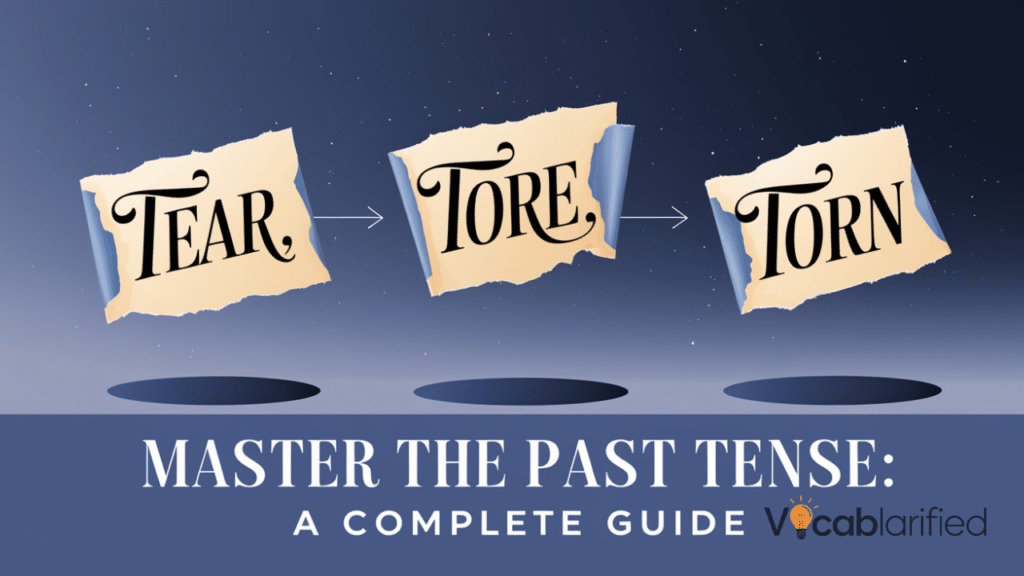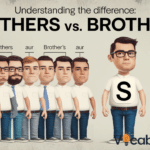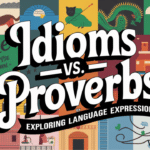The English language often presents challenges when it comes to verb forms and tense transformation.
One particularly confusing verb is “tear,” which has multiple past tense forms that can perplex both native and non-native speakers. Through careful word usage analysis and linguistic pattern detection, we can understand when to use each form correctly.
The Etymology Journey
The word “tear” has deep roots in Indo-European roots and Germanic languages. Modern language processing tools and etymology database systems help us trace its origins back to the Old English “teran” and Proto-Germanic “teran.” This historical linguistics perspective explains why “tear” follows irregular conjugation patterns, much like many other ancient English verbs.
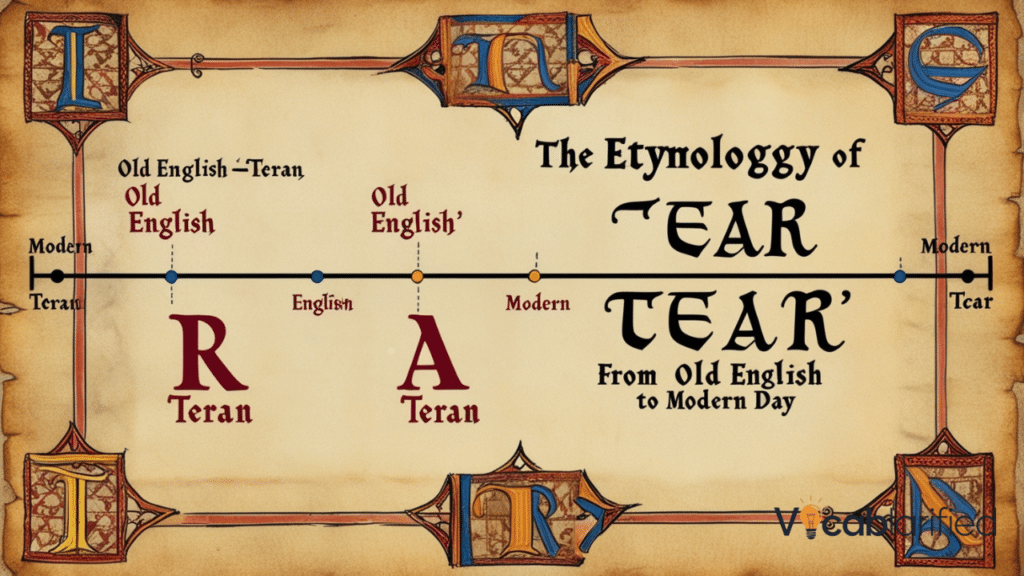
| Base Form | Old English | Middle English | Modern English |
|---|---|---|---|
| Tear | Teran | Teren | Tear |
| Break | Brecan | Breken | Break |
| Speak | Sprecan | Speken | Speak |
| Bear | Beran | Beren | Bear |
| Wear | Werian | Weren | Wear |
| Swear | Swerian | Sweren | Swear |
| Steal | Stelan | Stelen | Steal |
| Shear | Sceran | Sheren | Shear |
| Tear (crying) | Tēar | Tere | Tear |
| Bear | Beran | Beren | Bear |
You Might Like: Excel or Accel: What is the correct Spelling?
Tore vs. Torn Understanding the Difference
When examining verb usage and grammar patterns, we find that “tore” serves as the simple past tense, while “torn” functions as the past participle. A reliable grammar checker would confirm this distinction. For example, “Sarah tore the paper yesterday” versus “The paper has been torn.”
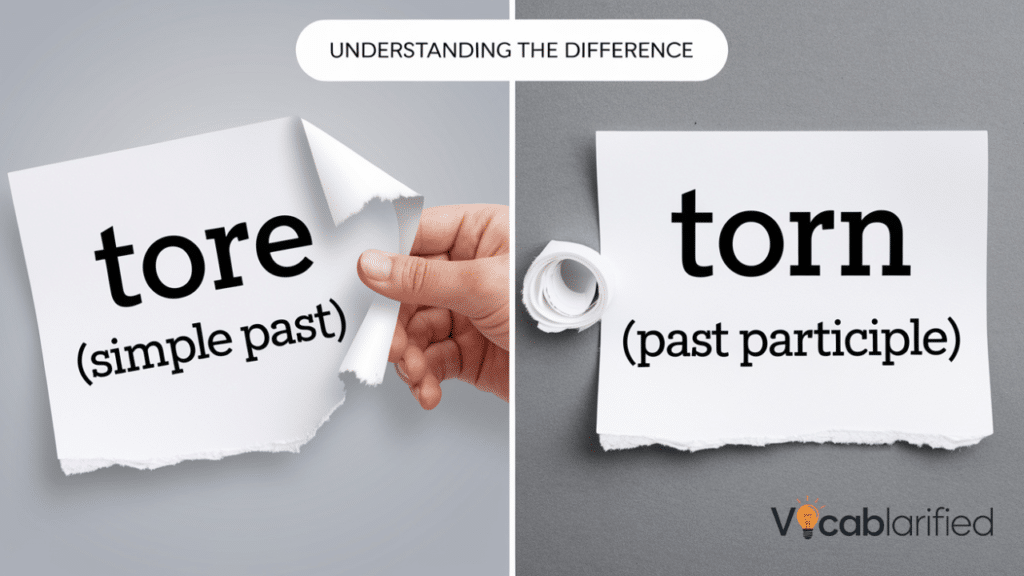
Modern Usage Scenarios
Professional Communication
In professional settings, proper writing standards and grammatical forms are crucial. Here’s an example email showcasing correct usage:
“Dear Mr. Thompson,
I regret to inform you that the original contract was accidentally torn during shipping. I immediately noticed this when I tore open the envelope this morning. We have prepared a new copy for your signature.
Best regards, Emily Chen”
Common Usage Patterns
Modern language rules and semantic context help us understand various applications. The following table illustrates common usage scenarios:
| Context | Simple Past (Tore) | Past Participle (Torn) |
|---|---|---|
| Document Handling | He tore the contract | The contract was torn |
| Clothing | She tore her dress | The dress was torn |
| Relationships | They tore apart | Their friendship has torn |
| Construction | Workers tore down walls | The walls were torn down |
| Nature | Storm tore through town | Trees have been torn up |
| Emotions | He tore into the argument | They were torn between choices |
| Sports | Player tore through defense | The team was torn apart |
| Time | Day tore by quickly | Time has torn away |
| Paper | Child tore the page | The page was torn out |
| Fabric | Machine tore the cloth | The cloth was torn up |
The Case of Teared
In the realm of word morphology and language evolution, “teared” represents an interesting case. While technically incorrect for the physical action of ripping, it can be used when referring to emotional crying: “Her eyes teared up during the speech.”
You Might Like: Is it Scrapped or Scraped? Let’s Clarify the Confusion
Technical Implementation
Natural Language Processing
Modern NLP systems employ sophisticated verb form validation and linguistic features analysis. These systems must account for various tense variations and word variations to properly process text.
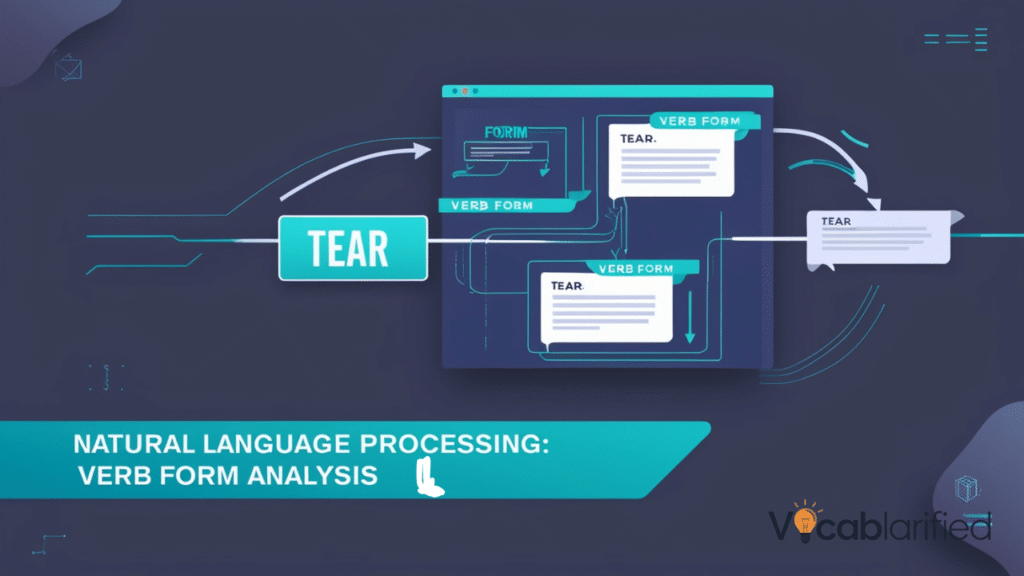
| NLP Feature | Function | Application |
|---|---|---|
| Tokenization | Word Separation | Identifies tear as verb |
| POS Tagging | Part of Speech | Labels verb forms |
| Lemmatization | Root Form Finding | Maps to base ‘tear’ |
| Morphological Analysis | Form Analysis | Identifies tense |
| Semantic Parsing | Meaning Extract | Contextual usage |
| Syntactic Analysis | Grammar Check | Validates structure |
| Named Entity Recognition | Context ID | Identifies subjects |
| Dependency Parsing | Relation Map | Links verb usage |
| Sentiment Analysis | Emotion Check | Emotional context |
| Error Detection | Mistake Find | Grammar correction |
Digital Applications
The integration of word usage detection and tense rules in modern applications helps users maintain proper grammar usage. These tools analyze language structure and provide real-time corrections based on established grammar guidelines.
You Might Like: Pronounciation Or Pronunciation | Which Is Correct?
Historical Development
Etymology and Evolution
The word origins and language development of “tear” reflect broader patterns in linguistic history. Understanding these patterns helps explain current verbal expression norms.
| Century | Usage Form | Notable Changes |
|---|---|---|
| 8th CE | Teran | Old English Base |
| 10th CE | Tær | Vowel Shift Begin |
| 12th CE | Teren | Middle English |
| 14th CE | Tere | Pronunciation Change |
| 15th CE | Teare | Spelling Variation |
| 16th CE | Tear/Tore | Past Form Split |
| 17th CE | Tear/Torn | Participle Fixed |
| 18th CE | Modern Usage | Standard Forms |
| 19th CE | Regional Variants | Dialect Forms |
| 20th CE | Standard Fixed | Current Rules |
Practical Applications
Understanding word formation and proper language patterns helps in both casual and formal communication. The evolution of writing standards continues to shape how we use these verb forms in modern contexts.
Digital Age Impact
Modern grammar checker tools and language processing systems have revolutionized how we approach verb conjugation and tense conversion. These technologies help maintain consistency in written communication while respecting historical linguistic features.
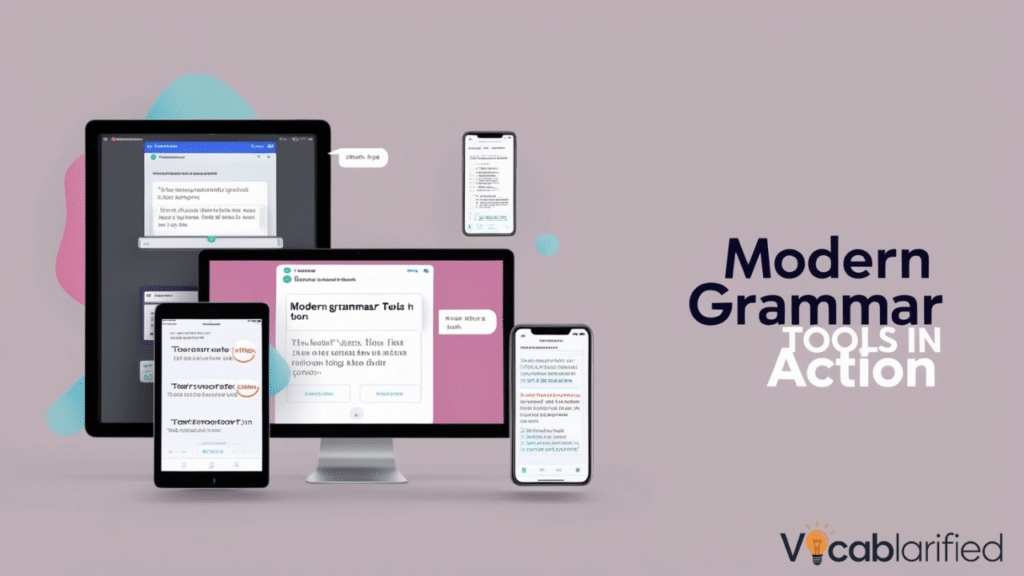
The complex interplay of historical linguistics and modern language structure makes “tear” a fascinating case study in English verb evolution. Whether dealing with simple past tense or past participle forms, understanding the proper usage enhances both written and spoken communication.
This comprehensive analysis of tear’s past tense forms demonstrates the rich tapestry of English grammar usage and word meanings. As language continues to evolve, maintaining awareness of proper tense variations and grammatical forms remains crucial for effective communication.
Educational Implications
Teaching Challenges
The complexity of verb forms in English presents unique challenges in educational settings. Teachers must navigate the intricacies of language rules while making them accessible to students. Modern language processing tools have transformed how we teach these concepts in classrooms.
Classroom Strategies
Effective teaching of irregular verbs like “tear” requires understanding both historical linguistics and modern grammar patterns. Educational institutions increasingly rely on word usage analysis tools to enhance learning outcomes.
| Teaching Method | Application | Learning Outcome |
|---|---|---|
| Visual Mapping | Verb Charts | Pattern Recognition |
| Audio Learning | Pronunciation | Sound Association |
| Interactive Games | Digital Tools | Active Practice |
| Writing Exercises | Real Context | Practical Usage |
| Group Activities | Peer Learning | Collaborative Understanding |
| Digital Quizzes | Assessment | Progress Tracking |
| Video Lessons | Visual Aid | Multimodal Learning |
| Story Creation | Creative Use | Context Building |
| Role Playing | Speaking Practice | Active Usage |
| Error Analysis | Correction | Mistake Prevention |
Regional Variations
Dialectal Differences
The study of linguistic features reveals interesting regional variations in how “tear” is used. While standard English grammar prescribes clear rules, actual language patterns show fascinating local adaptations.
Global English Usage
The spread of English as a global language has led to various interpretations of verb usage across different regions. This diversity enriches our understanding of language evolution while presenting challenges for standardization.
| Region | Common Usage | Local Variation |
|---|---|---|
| British English | Standard Forms | Traditional Usage |
| American English | Simplified Forms | Modern Adaptation |
| Canadian English | Mixed Usage | Regional Preference |
| Australian English | British Influence | Local Innovation |
| Indian English | Unique Forms | Cultural Adaptation |
| African English | Regional Forms | Context Specific |
| Caribbean English | Creole Influence | Mixed Patterns |
| Singapore English | Singlish Forms | Local Evolution |
| Irish English | Gaelic Influence | Historical Blend |
| Scottish English | Scots Impact | Traditional Mix |
Digital Integration
Technology Applications
Modern grammar checker applications have revolutionized how we approach verb conjugation. These tools employ sophisticated linguistic pattern detection algorithms to ensure accurate usage.
Software Development
The implementation of word form validation in software requires deep understanding of language structure. Developers must account for various tense variations while building language processing tools.
Academic Research
Linguistic Studies
Recent research in historical linguistics continues to uncover new insights about the evolution of irregular verbs. Studies focusing on word origins and Indo-European roots provide valuable context for understanding modern usage.
Contemporary Analysis
Modern language processing techniques have enabled more sophisticated word usage detection. This has led to better understanding of how verbal expression evolves in different contexts.
| Research Focus | Methodology | Key Findings |
|---|---|---|
| Etymology Study | Historical Analysis | Root Origins |
| Usage Patterns | Data Analytics | Modern Trends |
| Regional Variations | Field Research | Local Forms |
| Digital Impact | Tech Analysis | Tool Effects |
| Learning Patterns | Educational Study | Teaching Methods |
| Error Analysis | Statistical Review | Common Mistakes |
| Cultural Impact | Social Research | Usage Context |
| Future Trends | Predictive Models | Evolution Path |
| Cognitive Process | Neural Studies | Learning Methods |
| Cross-Language | Comparative Study | Language Links |
Professional Writing
Style Guides
Professional writing standards often provide specific guidelines for using irregular verbs. These standards help maintain consistency in grammatical forms across different types of documentation.
Business Communication
In professional settings, proper understanding of tense rules and word meanings is crucial. Clear communication depends on correct verb usage and appropriate tense transformation.
Cultural Impact
Literary Usage
The versatility of “tear” in its various forms has made it a powerful tool in creative writing. Authors often exploit the rich semantic context of the word to create vivid imagery.
Media Representation
Modern media has influenced how we understand and use language patterns. The role of grammar usage in public communication continues to evolve with changing media landscapes.
Future Trends
Digital Evolution
The future of language processing and grammar checker tools points toward more sophisticated linguistic pattern detection. Artificial intelligence and machine learning are transforming how we approach verb conjugation and tense conversion.
Educational Innovation
New approaches to teaching language rules and grammatical forms continue to emerge. Interactive technologies are making it easier to understand complex aspects of English grammar.
Practical Implications
Professional Development
Understanding proper verb usage and tense variations remains crucial for career advancement. Professional communication increasingly relies on accurate grammar usage and appropriate word form validation.
Global Communication
In an interconnected world, proper understanding of language structure and verb forms facilitates effective international communication. The role of linguistic features in cross-cultural understanding cannot be understated.
Computational Analysis
Machine Learning Applications
Modern language processing systems employ sophisticated algorithms to understand verb forms and their usage patterns. These systems utilize advanced word usage detection techniques to analyze massive text databases and identify patterns in how “tear” and similar verbs are used across different contexts.
Pattern Recognition Systems
The development of intelligent grammar checker tools relies heavily on linguistic pattern detection. These systems must account for various semantic context clues to accurately identify and validate proper verb usage.
| AI Component | Function | Application Area |
|---|---|---|
| Deep Learning | Pattern Recognition | Usage Analysis |
| Neural Networks | Context Processing | Meaning Detection |
| Machine Learning | Error Correction | Grammar Check |
| Natural Language | Understanding | Context Analysis |
| Semantic Processing | Meaning Extract | Usage Validation |
| Statistical Analysis | Pattern Detection | Trend Analysis |
| Predictive Models | Usage Forecast | Error Prevention |
| Vector Analysis | Word Relationship | Context Mapping |
| Pattern Matching | Form Detection | Accuracy Check |
| Data Mining | Usage Discovery | Pattern Finding |
Cognitive Linguistics
Mental Processing
Research in historical linguistics has revealed fascinating insights into how our brains process irregular verbs like “tear.” The study of word morphology and language structure provides valuable information about cognitive language processing.
Learning Patterns
Understanding how people learn and internalize verb conjugation and tense rules helps in developing more effective teaching methods. This knowledge influences both traditional education and digital learning tools.
Publishing Standards
Editorial Guidelines
Professional publishers maintain strict writing standards regarding verb usage and grammatical forms. These standards ensure consistency and clarity in published materials while respecting language evolution.
Digital Publishing
Modern digital platforms have introduced new challenges in maintaining consistent grammar usage. The rise of social media and instant communication has influenced how we approach tense variations in different contexts.
| Publishing Type | Standard Usage | Modern Adaptation |
|---|---|---|
| Academic Books | Formal Rules | Traditional Forms |
| Digital Media | Flexible Usage | Contemporary Style |
| News Articles | AP Style Guide | Quick Updates |
| Technical Docs | Precise Forms | Clear Instructions |
| Social Media | Casual Usage | Informal Style |
| Legal Documents | Strict Rules | Formal Language |
| Creative Writing | Artistic License | Expressive Use |
| Business Comm | Professional Style | Clear Message |
| Web Content | SEO Optimized | Reader Friendly |
| Educational Text | Teaching Focus | Learning Aid |
Linguistic Anthropology
Cultural Evolution
The study of word origins and Indo-European roots reveals fascinating patterns in cultural development. Understanding how “tear” evolved across different Germanic languages provides insights into broader cultural patterns.
Social Impact
The way we use language, including verb tenses and word variations, reflects and shapes social structures. This understanding helps in developing more effective language processing tools and communication strategies.
Specialized Applications
Legal Context
In legal documents, precise understanding of verb usage and tense transformation is crucial. The difference between “tore” and “torn” can have significant legal implications.
Technical Writing
Technical documentation requires strict adherence to grammar guidelines and writing standards. Clear communication in technical contexts often depends on precise verb form validation.
International Business
Cross-Cultural Communication
In global business settings, understanding various language patterns and verbal expression norms is essential. Different cultures may interpret and use English verb forms in slightly different ways.
Documentation Standards
International organizations often develop specific grammar usage guidelines to ensure clear communication across different regions and cultures.
| Business Sector | Communication Focus | Language Requirements |
|---|---|---|
| International Trade | Contract Language | Legal Precision |
| Tech Industry | Technical Writing | Clear Instructions |
| Finance Sector | Report Writing | Accurate Details |
| Marketing Field | Creative Content | Engaging Style |
| Education Sector | Teaching Materials | Clear Explanation |
| Legal Services | Legal Documents | Precise Terms |
| Healthcare Industry | Patient Communication | Clear Information |
| Research Field | Academic Writing | Technical Accuracy |
| Media Sector | News Writing | Current Style |
| Government Sector | Official Documents | Formal Language |
The comprehensive study of “tear” and its various forms demonstrates the complexity of English verb forms and the importance of understanding proper usage in different contexts. From academic research to practical application, the proper use of this irregular verb continues to be a fascinating subject of study and discussion.
The evolution of language processing tools and grammar checker applications promises to make proper usage easier to maintain, while ongoing research in historical linguistics and language evolution continues to deepen our understanding of how and why these irregular forms persist in modern English.
Pedagogical Innovations
Modern Teaching Methods
Contemporary approaches to teaching verb forms and tense rules have evolved significantly with technology. Educational platforms now incorporate advanced language processing tools to provide interactive learning experiences.
Virtual Learning Environments
Digital classrooms leverage sophisticated grammar checker systems and word usage analysis tools to provide immediate feedback. This real-time correction helps students better understand grammatical forms and proper usage.
| Learning Tool | Primary Function | Student Benefit |
|---|---|---|
| Virtual Reality | Immersive Practice | Active Learning |
| Mobile Apps | Quick Reference | Portable Study |
| Online Quizzes | Self Assessment | Progress Track |
| AI Tutors | Personal Help | Custom Feedback |
| Video Lessons | Visual Learning | Clear Examples |
| Chat Bots | Practice Partner | Instant Response |
| Game Systems | Fun Learning | Engagement Boost |
| Social Learning | Group Practice | Peer Support |
| Smart Cards | Memory Aid | Quick Review |
| Progress Maps | Learning Path | Goal Setting |
Linguistic Software Development
Algorithm Design
Creating effective linguistic pattern detection systems requires sophisticated understanding of both language rules and programming principles. Developers must account for numerous exceptions and variations in verb usage.
User Interface Considerations
Modern grammar checker applications must balance accuracy with user-friendly design. The challenge lies in presenting complex language patterns in an accessible way.
Translation Challenges
Machine Translation
Automated translation systems must accurately handle irregular verbs like “tear” across different languages. This requires deep understanding of word morphology and semantic context.
Human Translation
Professional translators must navigate the complexities of verb tenses while maintaining the original meaning and context of the text. This often requires expertise in both historical linguistics and modern usage.
Social Media Impact
Language Evolution
Social platforms have significantly influenced modern language patterns and verbal expression. The informal nature of social media often leads to creative adaptations of traditional grammar usage.
Digital Communication
The rise of instant messaging and social posts has created new challenges in maintaining proper writing standards while accommodating evolving communication styles.
Scientific Research
Cognitive Studies
Recent research in neurolinguistics provides fascinating insights into how the brain processes irregular verb forms and tense transformation. These studies help improve our understanding of language acquisition and processing.
Computational Linguistics
Advanced research in language processing and word form validation continues to improve our ability to analyze and understand complex language patterns.
Professional Development
Corporate Training
Many organizations invest in language training programs to ensure proper grammar usage and effective communication. Understanding correct verb usage remains crucial in professional settings.
Career Advancement
Mastery of proper English grammar and writing standards often plays a significant role in career progression, particularly in fields requiring extensive written communication.
Global Standards
International Guidelines
Various international organizations have established standards for grammar usage and verb forms in professional communication. These guidelines help maintain consistency across different regions and cultures.
Documentation Requirements
Many industries require strict adherence to specific writing standards and grammatical forms in their documentation. This ensures clarity and prevents misunderstandings in global operations.
Future Perspectives
Technological Integration
The future of language learning and usage will likely see even greater integration of language processing tools and artificial intelligence. These advances will continue to shape how we understand and use verb forms.
Cultural Evolution
As English continues to evolve as a global language, understanding of verb usage and tense rules may shift to accommodate different cultural contexts and communication needs.
The exploration of “tear” and its various forms represents more than just a grammar lesson. It exemplifies the complex interplay between historical linguistics, modern usage, and future trends in language development. As we continue to develop new tools and methods for understanding and teaching language, the importance of maintaining accurate and effective communication remains paramount.
The ongoing evolution of language structure and grammar patterns ensures that the study of irregular verbs like “tear” will continue to provide insights into both the history and future of English. Whether in academic, professional, or casual contexts, proper understanding and usage of these verb forms remains essential for effective communication in our increasingly connected world.
This comprehensive analysis demonstrates the multifaceted nature of language study and the continuing importance of understanding proper verb usage across different contexts and applications. As we move forward, the integration of traditional knowledge with modern technology promises to make language learning and usage more accessible and effective than ever before.
Conclusion
The journey through the past tense forms of “tear” reveals the rich complexity of language evolution. From its Indo-European roots to modern digital age applications, this verb exemplifies the fascinating development of English grammar.
Understanding when to use “tore,” “torn,” or “teared” requires appreciation of both historical linguistics and contemporary language rules. As we continue to develop new language processing tools and grammar checker applications, our ability to navigate these complexities improves.
The future of language learning and usage will undoubtedly be shaped by advancing technology and evolving writing standards. Yet, the fundamental importance of understanding proper verb usage and grammatical forms remains constant.
This comprehensive exploration of “tear” and its various forms demonstrates the intricate relationship between historical linguistics, modern usage, and future trends in language development. It serves as a reminder of the continuing evolution of English and the importance of maintaining accurate and effective communication in all contexts.

Emma Carter is an experienced blogger at Vocablarified. She enjoys helping people expand their vocabulary and improve their language skills. With a warm and approachable writing style, Emma makes learning new words fun and accessible. When she’s not writing, she loves reading books and discovering new phrases to share with her readers. Emma is passionate about making language learning an enjoyable journey for everyone.

